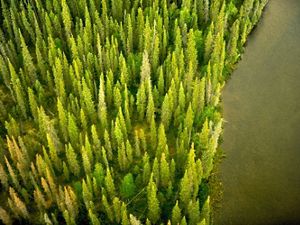Natural Climate Solutions
New science led by Nature United reveals nature can deliver immediate impact in Canada’s fight to tackle the climate crisis
Natural Climate Solutions are actions to protect, better manage and restore nature to reduce greenhouse gas emissions. Combined with cutting fossil-fuel use, boosting energy efficiency and accelerating clean-energy innovation, Natural Climate Solutions offer powerful and cost-effective ways to tackle the climate crisis.
New science led by Nature United with 16 other research institutions shows that Natural Climate Solutions can reduce Canada’s emissions by up to 78 megatonnes of CO2e annually in 2030. The study was peer-reviewed and published in Science Advances.
Media Inquiries: (416) 526-7353 | jacqueline.nunes@natureunited.ca
Key Findings
-
78 Mt
By protecting, better managing and restoring nature, Canada can reduce its greenhouse gas emissions by up to 78 Mt CO2e annually in 2030.
-
3 years
Natural Climate Solutions can reduce Canada’s annual greenhouse gas emissions by an amount equal to emissions from powering every single home in Canada for about 3 years.
-
11%
The annual potential for Natural Climate Solutions in 2030 is equal to 11% of Canada’s current annual carbon emissions.
Quote: Hadley Archer

Natural Climate Solutions are available now, are cost-effective and are vital to reducing Canada’s emissions and tackling the climate crisis.
Natural Climate Solutions draw on the power of nature to help reduce emissions, remove carbon dioxide from the atmosphere, and store it in natural systems.
Every action—or “pathway”—evaluated in the study involve protecting, better managing or restoring nature. For example, we can protect forests so that stored greenhouse gases aren’t emitted into the atmosphere. We can restore logged forests by planting new trees. And we can better manage forests so that carbon-rich trees have more years to grow after logging and trees that are cut down turn into wood products with a longer life-span.
Each of these actions help mitigate climate change by allowing nature to store and sequester more carbon.
The study examines four ecosystems—agricultural lands, forests, wetlands and grasslands—and highlights 24 pathways for climate action.
Our planet has always used natural carbon-storage processes in plant matter, soil and oceans. Natural Climate Solutions provide an opportunity to leverage this power of nature in the fight against climate change. Unlike other emergent technologies of carbon capture and storage, Natural Climate Solutions are available now and can be advanced without innovation, technical advancements or market developments.
Natural Climate Solutions in Action
The study examined four ecosystems and 24 pathways that, undertaken in the next decade, have the potential to cut Canada’s greenhouse gas emissions by an amount equal to 11% of our current annual emissions.
Agricultural Lands
Agricultural lands represent the biggest opportunity in 2030, accounting for 48% of the mitigation potential identified. Promising pathways include the widespread planting of cover crops to keep soil healthy, as well as nutrient management by efficient use of fertilizers and expanding the use of trees in agriculture.
Wetlands
The study examined seagrass, salt marsh, freshwater mineral wetlands, and the most common wetland type in Canada, peatlands. The second-largest opportunity in 2030 comes from avoiding peatland disturbance—that is, limiting activities like developing mines, building road and seismic lines across peatlands or harvesting peat for horticulture.
Forests
Conserving old-growth forests in managed forest lands, increasing the rate of growth of new trees in logged areas, and not burning post-logging woody residues so they can be converted into bioenergy can deliver significant near-term mitigation. Protecting forests and planting and maintaining trees in cities and suburbs also provides an important pathway of action.
Grasslands
Protecting grasslands from conversion to cropland and empowering farmers to maintain grassy buffers around rivers and lakes can protect water sources from run-off, sustain critical grassland habitat and sequester and store carbon.
Immediate improvements to the way forests are managed can deliver significant, long-term mitigation potential by 2050.

Forests can deliver emissions reductions of approximately 11.9 Mt CO2e per year—or 15% of total opportunity in 2030 identified in the study. While tree planting and restoring forest cover showed little near-term mitigation potential, this pathway was the winner by 2050. Canada offers an opportunity to expand forest cover across millions of hectares where trees are the natural vegetation—a practice that can yield 24.9 Mt CO2e/yr in 2050.
The most promising near-term opportunity in forests (7.9 Mt CO2e per year in 2030) relates to improved management, which involves protection of old-growth, growth enhancement of trees regenerating in logged areas and changing the product mix away from short-lived wood products like paper to long-lived products such as building materials.
The study highlights actions that are cost effective with several of the pathways available at less than $50 per tonne of CO2e.
Many of these opportunities are available now. Protection, management and restoration pathways will create new jobs and provide alternative revenue streams to Indigenous communities, farmers, ranchers, and foresters to help stimulate our economy.

This study is the first-ever comprehensive evaluation of the potential of nature to mitigate greenhouse gas emissions in Canada. The estimates include the cost per tonne of CO2e mitigation as well as an assessment of the uncertainty associated with the mitigation estimates.
Natural Climate Solutions also deliver social and environmental outcomes that help ecosystems flourish and communities thrive.
When developed and implemented in direct partnership with governments, Indigenous and local communities, and industry, Natural Climate Solutions make communities healthier and safer by contributing to cleaner water, air and food production; protecting against wildfires, droughts and flooding; and providing recreational spaces. They also deliver tremendous air, water, and soil benefits, helping to conserve biodiversity by protecting and restoring habitat for important species. And they will immediately create new jobs, stimulate local economies, and contribute to economic recovery.
The study documents evidence for co-benefits that accompany each pathway.
Thriving Communities






Clean Air and Water






Improved Biodiversity





The study estimates the annual mitigation potential for each province with greatest potential in Saskatchewan, Ontario, Quebec, British Columbia and Manitoba.
More Resources
- Infographic (.pdf)
- Study Overview (.pdf)
- Factsheet (.pdf)
- Figure 1 (.pdf)
The wetlands and forests of the Northwest Territories and the Yukon hold among the highest carbon stores in Canada. But the threats of conversion are the highest in southern Canada, which creates the opportunity for Natural Climate Solutions being additional to “business as usual.” The study focuses on areas of high capacity for sequestering greenhouse gas emissions or ecosystems that are at high risk of conversion, which are primarily in southern Canada. Avoiding land use changes or actions to increase sequestration in these areas can result in significant mitigation of climate change.
The mapper below shows mitigation possible for Canada’s provinces at three different price points, as well as the maximum mitigation potential. These price points correspond to Canada’s system of pricing carbon. For each Natural Climate Solution we estimated the costs related to implementation and other associated costs (for instance, opportunity costs related to land use alternatives to nature-based climate solutions) to estimate marginal abatement costs, that is, the monetary cost of achieving one additional ton of sequestered greenhouse gases or avoided greenhouse gas emissions.
Download the Study
Natural Climate Solutions for Canada
Published in Science Advances on June 4, 2021
Read via Science AdvancesThis study was possible thanks to an effort between Nature United and our global affiliate in collaboration with experts from 16 other institutions: Agriculture and Agri-Food Canada, Natural Resources Canada, Clark University, Cornell University, Ducks Unlimited Canada, Viresco Solutions, Hakai Institute, McGill University, University of Guelph, University of Toronto, University of Vermont, University of Waterloo, University of Wisconsin-Madison, University of British Columbia.
This study is made possible by funding from Metcalf Foundation, Hewlett Foundation, RBC Foundation, McCall MacBain Foundation, Echo Foundation and Tula Foundation.
Natural Climate Solutions are powerful, cost effective and can be implemented right now.
This study is an urgent call-to-action for governments, industries and communities to change the way we protect, manage and restore lands and waters in Canada, and to accelerate Natural Climate Solutions through market transformation, policy incentives and regulation.
Combined with innovations in clean energy and other efforts to decarbonize the world’s economies, Natural Climate Solutions are vital for meeting Canada’s global emissions targets by 2030 and reaching net-zero emissions by 2050. And they make communities healthier and safer, help to conserve biodiversity, and stimulate local economies.
Over the next decade, Nature United will work with Indigenous communities, all levels of government and across all sectors to accelerate the funding, adoption and implementation of Natural Climate Solutions. Nature United has a proven track record of building diverse partnerships to protect lands and waters and ensure nature is the foundation of healthy communities and economies.
In the early years, our efforts will create the conditions for accelerating Natural Climate Solutions—for example, supporting Indigenous authority and investing in Indigenous-led conservation, and introducing policy incentives to encourage new agriculture and forestry practices. We will also invest in projects on the ground that not only reduce greenhouse gas emissions but also create models for collaborative projects across Canada—building on our decade-long record of advancing conservation in Canada.
We are calling on decision-makers in Canada to invest now in Natural Climate Solutions (protecting, better managing and restoring nature) as part of an integrated strategy to drastically cut greenhouse-gas emissions and keep warming below 1.5C.
Ground-breaking Methodology
The study Natural Climate Solutions for Canada developed several innovative methods that build on the approaches used in the global study (Proceedings of the National Academy of Sciences) and U.S. study (Science Advances) examining Natural Climate Solutions. These innovations included an examination of the role of albedo in pathways that include trees.
Albedo refers to how the land surface reflects incoming solar energy. Changes in land cover can decrease albedo and cause local warming by increasing the amount of solar energy absorbed by land. Our estimates relied on novel analyses to account for this albedo deduction to improve the accuracy of estimates of mitigation potential.
Thank You to Our Donors
The following donors have supported this work from FY19 to the present:















